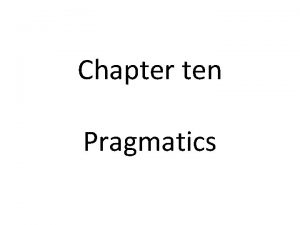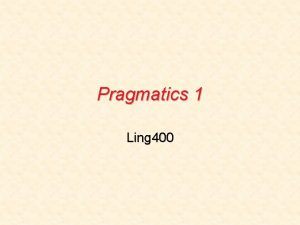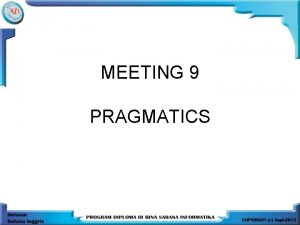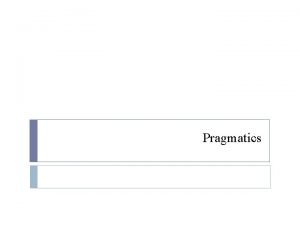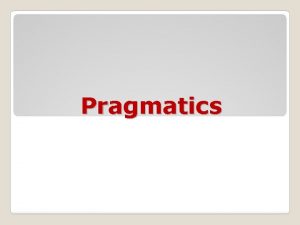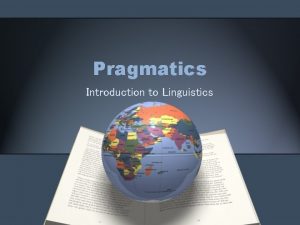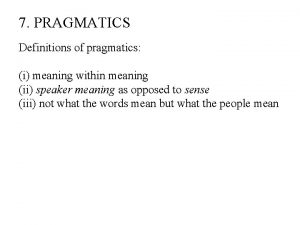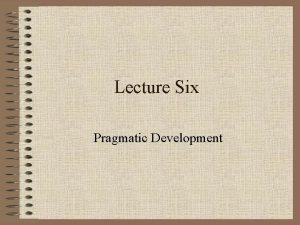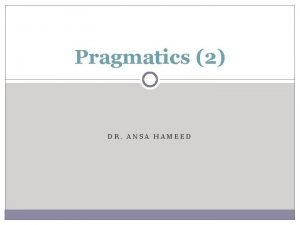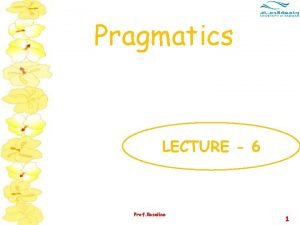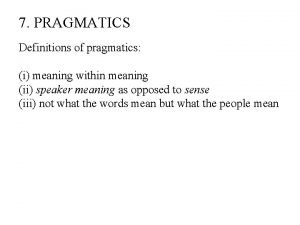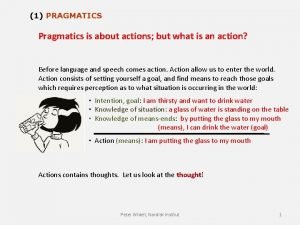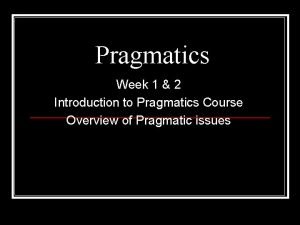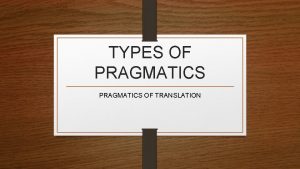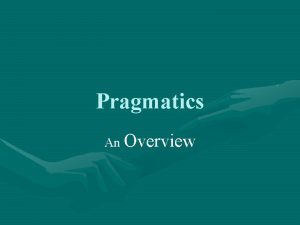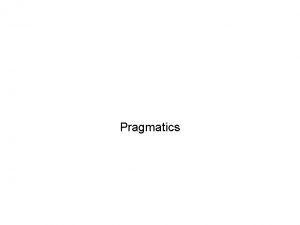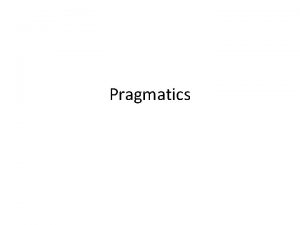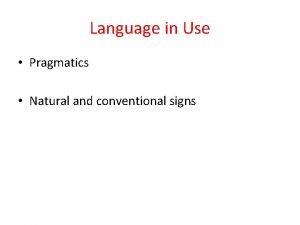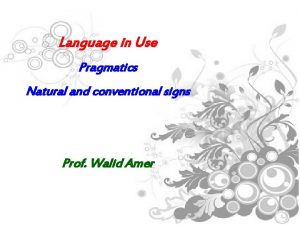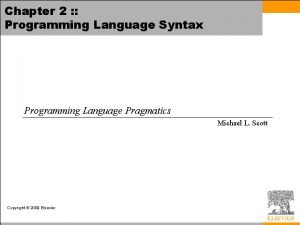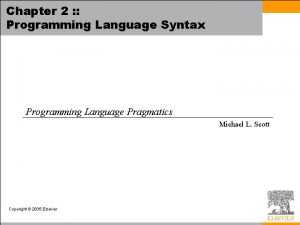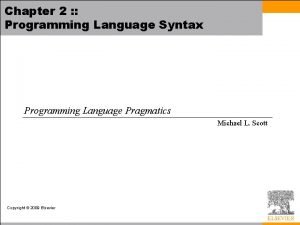Pragmatics Pragmatics studies language in use and the
































- Slides: 32

Pragmatics

Pragmatics studies language in use and the contexts in which it is used. It studies deixis, roles in conversation, text organization, presupposition, and implicature.

Invisible meaning • Pragmatics is the study of invisible meaning, that is how to recognize the underlined meanings which are not apparently said or written

Context • Context refers to the circumstances that form the setting for an event, statement, or idea, and in terms of which it can be fully understood.

Example (bank) • Bank can mean a financial institution or side of river. • How do we know which meaning is intended in a particular sentence? • We normally do so on the basis of linguistic context.

• If the word bank is used in a sentence together with words like steep or overgrown, we know that it is the side of the river. • Or, if we hear someone say “I need to go to the bank to withdraw cash, ” we understand that it is a financial institution.

Deixis refers to words and phrases, such as “me” or “here”, that cannot be fully understood without additional contextual information. It is often and best described as "verbal pointing", that is to say pointing by means of language. The linguistic forms of this pointing are called deictic expressions, deictic markers or deictic words.

Deictic expressions include such lexemes as: • Personal deixis: (you/mine/your/him/them, those idiots) , • Demonstrative deixis (this/that, these, those), • (Spatial/temporal) deixis (here/there/near, now, tomorrow, last week) ,

• Deixis is clearly tied to the speaker's context, the most basic distinction being between near the speaker (proximal) and away from the speaker (distal). • Proximal deictic expressions include this, here and now. • Distal deictic expressions include that, there and then

Reference • Reference is an act by which a speaker (or writer) uses language to enable a listener (or reader) to identify something.

• To perform an act of reference, we can use proper nouns: (Chomsky, Jennifer, Whiskas), other nouns in phrases (a writer, my friend, the cat) or pronouns (he, she, it).

The choice of one type of referring expression rather than another seems to be based on what the speaker assumes the listener already knows.

Inference • An inference is additional information used by the listener to create a connection between what is said and what must be meant.

• For example, in a restaurant, one waiter can ask another, Where’s the spinach salad sitting? and receive the reply, He’s sitting by the door. • If you’re studying linguistics, you might ask someone, Can I look at your Chomsky? and get the response, Sure, it’s on the shelf over there. These examples make it clear that we can use names associated with things (salad) to refer to people, and use names of people (Chomsky) to refer to things.

Anaphora • Anaphora is the use of an expression that depends specifically upon an antecedent expression. • Susan dropped the plate. It shattered loudly. • The pronoun it is an anaphor; it points to the left toward its antecedent the plate.

• If Sam buys a new bike, I will do it as well. • The verb phrase do it is anaphor; it points to the left toward its antecedent buys a new bike.

Cataphora • Cataphora is the use of an expression that depends upon a postcedent expression. • Because he was very cold, David put on his coat. • The pronoun he is a cataphor; it points to the right toward its postcedent David. • Although Sam might do so, I will not buy a new bike. • The verb phrase do so is a cataphor; it points to the right toward its postcedent buy a new bike.

Presupposition • What a speaker (or writer) assumes is true or known by a listener (or reader) can be described as a presupposition.

Examples • Jane no longer writes fiction. • Presupposition: Jane once wrote fiction. • Have you stopped eating meat? • Presupposition: you had once eaten meat. • Have you talked to Hans? • Presupposition: Hans exists.

Speech acts • The philosopher J. L. Austin (1911 - 1960) claims that many utterances (things people say) are equivalent to actions. • We use the term speech act to describe actions such as ‘requesting’, ‘commanding’, ‘questioning’ or ‘informing’.

Direct and indirect speech acts

• When an interrogative structure such as Did you. . . ? , Are they. . . ? or Can we. . . ? is used with the function of a question, it is described as a direct speech act.

Can you pass the salt? • In this example, we are using a syntactic structure associated with the function of a question, but in this case with the function of a request. • This is an example of an indirect speech act.

Politeness • Politeness can be defined as showing awareness of and consideration for another person’s face.

• (Give me that paper!), you are behaving as if you have more social power than the other person. • If you do not have that power, you are performing a facethreatening act.

• (Could you pass me that paper? ), removes the assumption of social power. • Whenever you say something that lessens the possible threat to another’s face, it can be described as a face-saving act.

Performative utterances 1. Locutionary 2. Illocutionary 3. Perlocutionary

1. Locutionary Act • • A locutionary act is the act of making a meaningful utterance. Example: “It is raining outside!” Locutionary act is the literal meaning of the utterance, that is, the meaning of the utterance which is carried by the words inthe utterance and their arrangement or their structure of words.

2. Illocutionary Act • Illocutionary act is performed via the communicative force of an utterance. • Illocutionary act is an utterance with some kind of function in mind.

3. Perlocutionary Act • Perlocutionary acts are the effects of the utterance on the listener

We will close the shop after 5 minutes • 1. Locutionary: Saying that the shop will be closed in 5 min. • 2. Illocutionary: The act of informing the customers of the shop’s forthcoming closing and perhaps also the act of urging them to order buy something.

• 3. Perlocutionary: The shopkeeper intends to be performing this act by causing the customers to believe the shop is about to close, and of getting them to want and to order one last orders! Buy something. Effect
 Paradigm shift from women studies to gender studies
Paradigm shift from women studies to gender studies Hình ảnh bộ gõ cơ thể búng tay
Hình ảnh bộ gõ cơ thể búng tay Slidetodoc
Slidetodoc Bổ thể
Bổ thể Tỉ lệ cơ thể trẻ em
Tỉ lệ cơ thể trẻ em Voi kéo gỗ như thế nào
Voi kéo gỗ như thế nào Tư thế worms-breton
Tư thế worms-breton Alleluia hat len nguoi oi
Alleluia hat len nguoi oi Kể tên các môn thể thao
Kể tên các môn thể thao Thế nào là hệ số cao nhất
Thế nào là hệ số cao nhất Các châu lục và đại dương trên thế giới
Các châu lục và đại dương trên thế giới Công của trọng lực
Công của trọng lực Trời xanh đây là của chúng ta thể thơ
Trời xanh đây là của chúng ta thể thơ Cách giải mật thư tọa độ
Cách giải mật thư tọa độ Làm thế nào để 102-1=99
Làm thế nào để 102-1=99 Phản ứng thế ankan
Phản ứng thế ankan Các châu lục và đại dương trên thế giới
Các châu lục và đại dương trên thế giới Thơ thất ngôn tứ tuyệt đường luật
Thơ thất ngôn tứ tuyệt đường luật Quá trình desamine hóa có thể tạo ra
Quá trình desamine hóa có thể tạo ra Một số thể thơ truyền thống
Một số thể thơ truyền thống Cái miệng nó xinh thế chỉ nói điều hay thôi
Cái miệng nó xinh thế chỉ nói điều hay thôi Vẽ hình chiếu vuông góc của vật thể sau
Vẽ hình chiếu vuông góc của vật thể sau Biện pháp chống mỏi cơ
Biện pháp chống mỏi cơ đặc điểm cơ thể của người tối cổ
đặc điểm cơ thể của người tối cổ Ví dụ giọng cùng tên
Ví dụ giọng cùng tên Vẽ hình chiếu đứng bằng cạnh của vật thể
Vẽ hình chiếu đứng bằng cạnh của vật thể Fecboak
Fecboak Thẻ vin
Thẻ vin đại từ thay thế
đại từ thay thế điện thế nghỉ
điện thế nghỉ Tư thế ngồi viết
Tư thế ngồi viết Diễn thế sinh thái là
Diễn thế sinh thái là Các loại đột biến cấu trúc nhiễm sắc thể
Các loại đột biến cấu trúc nhiễm sắc thể

































